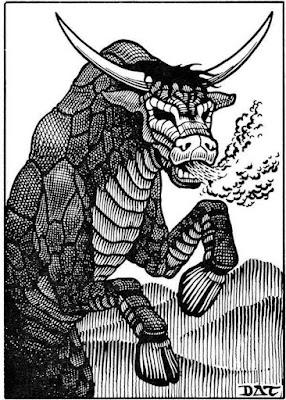For some reason, when he was writing the White Box set for D&D, Gary Gygax decided to make Gorgons not Medusa and her immortal sisters, but metal-plated bulls with petrifying breath. This has been how gorgons were depicted in every edition of the game thereafter.
This may have been inspired by The Historie of Foure-Footed Beastes, written by Edward Topsell, and published in 1607. Or it might have been influenced by Topsell's book indirectly, as I have seen occasional references to D&D-type gorgons in other works. Although I could not for the life of me tell you what those works were, I am fairly certain that they cribbed from Topsell, who would have long been in the public domain by the time they were written. Topsell's gorgon had poisonous, rather than petrifying, breath from eating poisonous herbs.
Other potential sources for the monster are the Greek Khalkotauroi or the Ethiopian Catoblepas, although that had its own entry in the AD&D Monster Manual. It seems likely (to me) that, regardless of Gygax's source, the gorgon's breath became petrifying because the creature's deadly breath was conflated with the Gorgon Medusa's ability to turn the living to stone.
Here are some statistics for using the bull-type gorgon in a DCC game:
Gorgon: Init +3; Atk gore +5 melee (2d6) or trample +6 melee (1d8) or deadly breath; AC 20; HD 6d8; MV 40’; Act 1d20; SP deadly breath every 1d5 rounds; SV Fort +8, Ref +5, Will +0; AL C.Deadly Breath: A gorgon has a breath weapon that forms a cloud with a 20' diameter, affecting all creatures within. To determine the effects of any given gorgon's breath weapon, roll 1d12:
(1-5) Petrifying. Victims must succeed in a DC 10 Will save or take 1d8 points of permanent Agility damage. This represents the body of the victim turning slowly to stone, and can be healed only by strong magic or bathing in the blood of the gorgon responsible. If Agility reaches 0 through this damage, the creature is completely petrified.
(6-9) Poisonous. Victims take 1d6 damage and must succeed in a DC 12 Fort save or take 1d4 points of temporary Stamina damage.
(10) Caustic. Victims take 1d6 damage, and must make a DC 10 Fort save or take 1d6 damage each round until the save succeeds.
(11) Memory-Eating. Victims must succeed in a DC 10 Will save or lose 1d6 XP. This can reduce characters' levels, as their memories of past success are eaten away. Anyone reduced to 0 XP takes Intelligence damage instead on a failed save.
(12) Pestilent. Victims must succeed in a DC 15 Fort save or become ill, taking an immediate 1 point of temporary Strength, Stamina, and Agility damage. Each day thereafter, the victim must make a DC 15 Fort save or suffer an additional 1d3 temporary damage to Strength, Stamina, and Agility. This damage does not begin to heal until the character has succeeded in three saves, which ends the pestilence, or the disease is removed by other means. Worse, the victim is contagious, and anyone in their company must make a DC 15 Fort save after each hour or fall victim to the same pestilence.
Have fun!


No comments:
Post a Comment